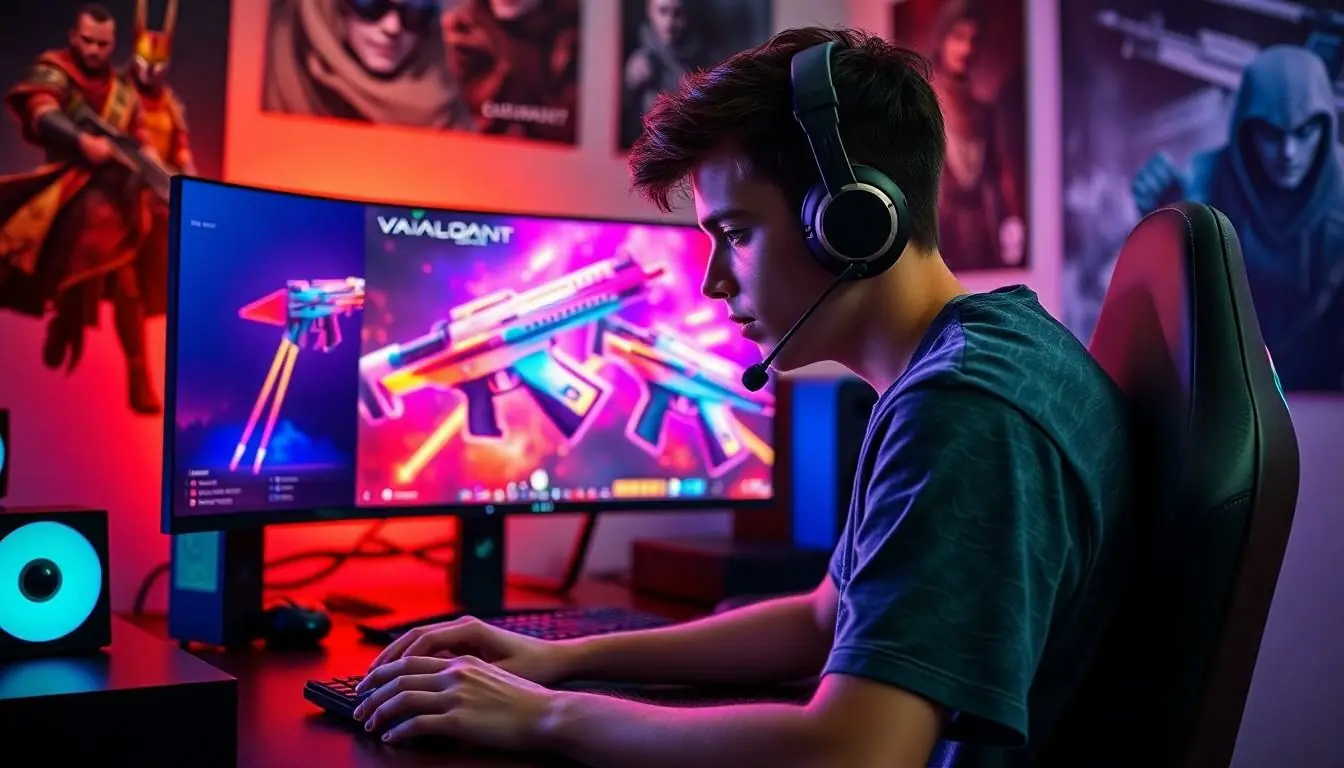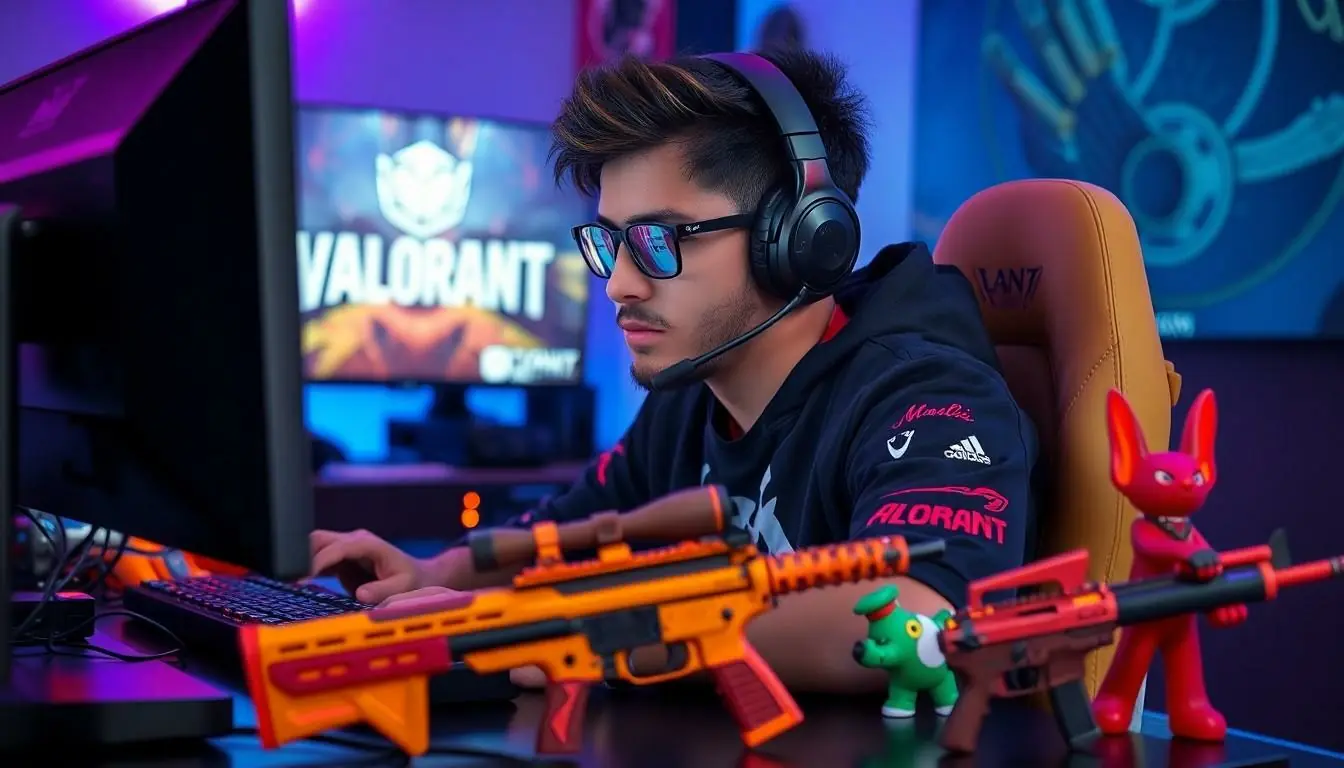Table of Contents
ToggleIn the ever-evolving world of gaming, few titles have captured players’ wallets quite like Valorant. From flashy skins to quirky gun buddies, this tactical shooter has turned many a casual gamer into a virtual fashionista. It’s not just about winning; it’s about looking good while doing it. Who knew that a simple headshot could come with a side of style?
As players dive into the game’s vibrant universe, they often find themselves pondering a pressing question: how much have they actually spent on those dazzling cosmetics? The spending history in Valorant is more than just numbers; it’s a testament to dedication, passion, and perhaps a touch of impulsive shopping. Join the journey through the fascinating world of Valorant spending, where every purchase tells a story and every skin has its own flair.
Overview of Valorant
Valorant, developed by Riot Games, stands out in the tactical shooter genre with its unique blend of characters and diverse gameplay. Players choose from agents, each possessing distinct abilities that enhance team dynamics and strategies. Set in a stylized, near-future world, the game offers various maps that challenge players to adapt and strategize.
The competitive structure in Valorant appeals to many gamers. Ranked play encourages improvement and skill development, drawing in players eager to climb through the tiers. Competitive matches require teamwork and communication, solidifying bonds among players and fostering a strong community.
Cosmetic items complement gameplay, allowing for personal expression. Purchase options range from skins for weapons to character-specific cosmetics, which create a sense of individuality among players. Curiously, many gamers prioritize cosmetic purchases to enhance their in-game experience, reflecting their dedication to the game’s aesthetic appeal.
Events and seasonal updates frequently introduce new content. Players remain engaged through limited-time skins and thematic collections, often leading to spikes in spending. Notably, the game’s microtransaction system fosters a continuous cycle of consumer engagement, with the vibrant marketplace appealing to players looking for exclusive items.
Understanding spending habits within Valorant reveals broader trends in gaming culture. Many players view their purchases as investments in both gameplay and personal expression. This phenomenon highlights the intersection of virtual identity and real-world consumer behavior, illustrating how Valorant reshapes the landscape of online gaming experiences.
Understanding In-Game Purchases
Players in Valorant engage with various in-game purchases to enhance their experience and showcase their style. These transactions not only reflect individual preferences but also contribute to the game’s vibrant ecosystem.
Types of Purchasable Items
Valorant offers several types of purchasable items, including skins for weapons, gun buddies, and player cards. Cosmetic skins allow players to customize the appearance of their weapons, adding personal flair during matches. Gun buddies provide small, decorative charms attached to weapons, further enhancing individual expression. Player cards serve as profile showcases, featuring artistic designs that represent players’ identities. Event-specific items also occur, bringing limited-time offerings that entice players during seasonal events.
Pricing Models in Valorant
Valorant utilizes a free-to-play model complemented by microtransactions. Players access the game without cost but can purchase Valorant Points (VP) using real money to buy in-game items. Prices for skins typically range from 1,775 VP to 3,500 VP, depending on rarity and type. Daily offers and bundles present additional purchasing options, often featuring discounts on popular items. The tiered pricing structure caters to diverse budgets, encouraging spending while allowing players to prioritize their preferences.
Analyzing Valorant Spending History
Valorant’s spending habits reveal various trends, offering insight into player behavior and motivations.
Initial Launch and Early Spending Trends
Upon release in June 2020, Valorant attracted a dedicated player base eager for its tactical gameplay. Early spending trends showed players investing in cosmetic items to enhance their experience. Cosmetic purchases, especially weapon skins, accounted for a significant portion of this spending. Riot Games capitalized on this enthusiasm by offering exclusive skins, leading to notable spikes in microtransactions. Data indicated that initial spending also helped players express their individuality, solidifying their identity within the game’s community. The excitement surrounding Valorant’s launch established a foundation for future spending, capturing player dedication through their purchases.
Seasonal Events and Their Impact on Spending
Seasonal events in Valorant critically influence spending patterns among players. Major updates often feature exclusive bundles or limited-time items, prompting increased interest and purchases. Events such as the “Valorant Episode” updates introduce powerful skins and themed cosmetics tied to each season. These limited-time offerings create urgency, encouraging players to buy before items disappear. Analysis showed that players spent more during events, often doubling their typical monthly purchases. Furthermore, community engagement during events fosters a spirit of competition, compelling players to showcase their unique styles through in-game purchases. This cycle of engagement and spending strengthens the connection between players and Valorant’s evolving universe.
Key Factors Influencing Spending Behavior
Several key factors influence spending behavior in Valorant, shaping how players engage with the game.
Player Demographics
Players of various ages and backgrounds contribute to unique spending patterns. A significant portion of Valorant’s audience consists of younger gamers aged 18 to 34, who often display a willingness to invest in cosmetic items. The accessibility of the game fosters a diverse player base, leading to varied preferences for skins and other collectible items. Research indicates that younger players prioritize aesthetics and personal representation, valuing distinctive styles that enhance their gameplay experience. Community engagement through social media and platforms like Twitch amplifies these purchasing behaviors, as players frequently showcase their collections and share tips, further motivating others to spend.
Game Updates and New Features
Game updates and new features create excitement that directly impacts spending. Riot Games employs a systematic approach to introduce new content, often aligning releases with seasonal events. Each update typically features exclusive skins, bundles, and limited-time offers that entice players to make purchases. The urgency created by these time-limited items plays a crucial role in stimulating sales and pushing players toward in-game transactions. In addition, new gameplay features frequently associated with updates enhance players’ overall experience, prompting many to invest more in their customization options. Players are likely to spend more when they feel their investment enhances both their enjoyment and connection to the game.
Conclusion
Valorant’s spending history reveals much about the game’s dedicated player base and their motivations. Players aren’t just investing in cosmetic items; they’re expressing their unique identities and enhancing their gaming experiences. The strategic introduction of exclusive skins and seasonal events has created a vibrant marketplace that resonates with the community.
As the game evolves, so do players’ spending habits, influenced by demographics and social engagement. Understanding these trends offers valuable insights into the intersection of gaming culture and consumer behavior. Ultimately, spending in Valorant reflects a deeper connection to the game and its community, showcasing how virtual experiences can shape real-world choices.





